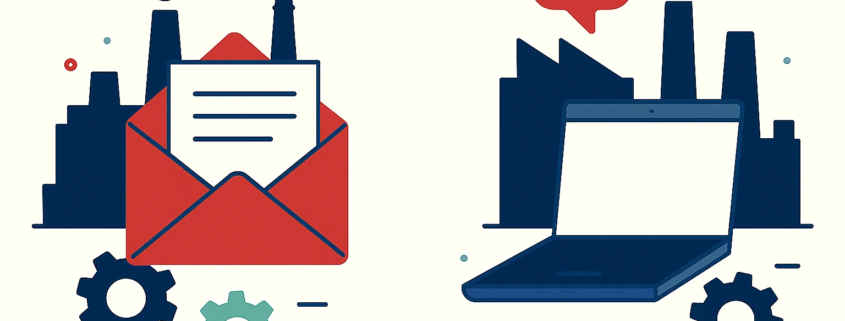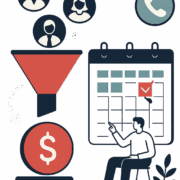Direct Mail vs Email Marketing in Manufacturing: Which Channel Drives Better B2B Lead Generation?
If you’re in manufacturing sales or marketing, there’s a good chance you’ve heard the debate: direct mail and email marketing. Both are used to generate B2B leads, both play their part in a modern outreach effort, and both can deliver robust ROI if done correctly. But if you’re operating in the realm of manufacturing, where there are long sales cycles, complex products, and multiple influencers, then you want to choose the right channel more than ever.
You don’t spend time on non-converting campaigns, and your salespeople can’t afford to chase warm leads who were never actively engaged in the first place. That’s why it’s necessary to understand the actual difference between email and direct mail and how each performs in B2B manufacturing.
In this guide, we’ll compare direct mail and email marketing for manufacturers. We’ll cover strengths, weaknesses, use cases, cost, engagement, and ROI. By the end, you’ll have a clear sense of which channel to prioritize and how to combine both for maximum impact.
Why This Matters in Manufacturing
B2B manufacturing sales are not for the faint of heart. Your buyers are technical, your product lines are specialty, and your decision-making is multi-level, including engineering, operations, procurement, and executive management.
With bigger contract values and longer purchasing cycles, lead quality trumps lead quantity. And in an atmosphere where focus is hard to get, how you start talking ends up dictating how you finish.
That is why smart manufacturing marketers always explore which channels hold the greatest promise to deliver to serious buyers. Whereas some have defaulted to email, direct mail has been seeing a full-fledged comeback in B2B, especially when done so through personalization and as part of multi-touch campaigns.
Let’s compare the two channels head-to-head.
What Is Direct Mail Marketing in Manufacturing
Direct mail is physical promotional mail that reaches the prospect’s business mailing address. Examples include brochures, letters, postcards, sample packages, and dimensional mailers.
Manufacturing companies can send direct mail in various forms. Some use booklets of product specs tailored to the individual prospect. Others use branded products with an introductory letter. The most successful programs use personalization, information, and aggressive design to gain attention and stand above the usual desk clutter.
Direct mail really shines at reaching:
- Plant managers and operations directors
- Engineering leaders who prefer hard specs and pictures
- Hard-to-reach decision-makers who are less responsive to digital channels
Direct mail works when it seems pertinent, intentional, and tailored. And when paired with digital follow-up, it can create a strong sense of familiarity before a sales rep ever speaks with them.
What Is Email Marketing in Manufacturing?
Email marketing involves sending electronic mail to a prospect or customer list, most often as part of a lead generation or nurture campaign.
It’s fast, trackable, and low-cost. Manufacturers’ email campaigns could comprise product announcements, case studies, whitepapers, or invite people to schedule a call. Using automation software, you can build workflows that respond to user activity and trigger series based on engagement.
Email marketing works best when:
- You possess segmented and up-to-date contact lists
- Your message addresses specific pain points in the buyer environment
- You supplement outreach with other outlets, like phone or LinkedIn
- Your salespeople are consistently following through on leads that show interest
Email can grow cheaply and quickly, but it has one built-in flaw: everybody does it. That means your message typically must battle through hundreds of others.
Direct Mail vs Email: A Channel Comparison for Manufacturers
Attention and Engagement
Direct Mail
Physical mail cuts through the electronic noise. Done effectively, it presents as personal and authentic, creating a tangible moment that prospects will likely remember. In most B2B settings, executives genuinely read most of the mail that they receive, especially when they open it is addressed to them.
Email
Email is generally less interactive, but you can contact more prospects faster. B2B open rates are 15% to 25%, with click-through rates closer to 2%. Subject lines, send times, and list quality depend heavily on interaction.
Winner: Direct Mail, especially for high-value accounts and new business.
Cost
Direct Mail
There is a higher upfront cost. You pay for design, printing, packaging, postage, and sometimes fulfillment. Campaigns cost anywhere from $3 to $25 per unit, depending on complexity. But for going after big-ticket accounts, the ROI can be amazing, even with small conversions.
Email
Email is cheap. You can send thousands of emails for pennies. With automation software and CRM integration, you can run large campaigns for low overhead.
Winner: Email, if cost per lead is the top priority.
Speed and Scale
Direct Mail
It takes longer to create and mail. List building, printing, and mailing took weeks of the campaign’s length. But whatever speed you give up, you typically gain in quality and rememberability.
Email
You can launch a campaign in a few hours, A/B message, subject line test, and monitor results with the push of a button. It’s fantastic for rapid iteration and bulk testing.
Winner: Email, for speed and numbers.
Personalization and Relevance
Direct Mail
Direct mail shines when it’s personalized. Referencing the recipient’s company, industry, or recent news shows you’ve done your homework. Pairing that with a physical gift or custom message adds a level of sincerity that’s hard to replicate digitally.
Email
You can merge fields and dynamic content to personalize in bulk. But if your data is dirty, personalization won’t work. And even good messages are likely to get lost in the busy inbox.
Winner: Direct Mail, due to depth of personalization and perceived value.
Lead Quality and Sales Outcomes
Direct Mail
Because of the expense and labor involved, direct mail is typically used for high-fit prospects. That necessarily increases the quality of leads that are generated. When paired with sales outreach, it is likely to lead to warmer conversations and better close rates.
Email
Email can generate a lot of responses, but not all of them will be from decision-makers or qualified buyers. While volume may be high, conversion rates can be lower if targeting isn’t precise.
Winner: Direct Mail, for quality. Email, for top-of-funnel activity.
Use Cases: When to Use Each Channel
Here’s how manufacturers can strategically use both channels depending on their goals.
Use Direct Mail When:
- You’re targeting a small group of high-value accounts
- You’re launching a new solution and want to make a strong first impression
- Your sales team needs warmer entry points into cold accounts
- You’re supplementing trade show outreach with personalized follow-up
- You’re reactivating dormant leads with something memorable
Use Email Marketing When:
- You’re nurturing a large list of leads over time
- You’re promoting content like case studies or whitepapers
- You need to drive webinar or event registrations
- You’re following up quickly after an initial call or inquiry
- You’re A/B testing to refine your messaging
Combining Direct Mail and Email for Maximum Impact
The magic doesn’t happen until you use the two channels in combination as part of a bigger outbound campaign: direct mail to open the door, email to continue the conversation, and together, a multi-touch experience building trust and engagement.
Try this:
- Day 1: Send a mailer with an intro to your firm and a printed case study
- Day 5: Follow up via email, personalized with a mention of the mailer
- Day 8: Contact to connect on LinkedIn with a short message
- Day 10: Call with mention of the mailer and email
- Day 14: Send a final email with a CTA to set up a call
This form of joint strategy can double or triple your response rate compared to using one channel in isolation. At Sapper, we see response rates double or triple when using direct mail and email combined correctly.
What Manufacturers Need to Think About When Choosing a Channel
Whether to choose direct mail or email is essentially answering a few key questions:
- What’s the value of each new customer or contract?
- Are you targeting a few key decision-makers or shooting wide?
- Do you have clean, segmented data to enable messages to be personalized?
- How quickly do you need results?
- Do you have the resources available to follow up in a good way?
If your average deal size is six figures, investing in a personalized mailer makes sense. If you’re trying to fill the top of your funnel fast, email is a smart first step. Most manufacturers will benefit from using both, but with a clear intent behind each channel.
Why Sapper Helps Manufacturers Win With Both Channels
We specialize in crafting outbound campaigns to convert manufacturers at Sapper. We do not mail or email. We create comprehensive outreach campaigns with the intent of establishing qualified B2B conversations on the right channels.
We organize:
- Prospect targeting and research
- Message development for email and direct mail
- Campain deployment
- CRM and reporting integration
- Appointment setting with fully qualified leads
Whether you are opening up new geography, reactivating sleeping accounts, or building pipeline from scratch, we tailor the channel blend to your goals.
You want to see direct mail and email together in actual sales dialogues? Let’s chat.
Last Thoughts: It’s Not Either/Or, It’s Strategy First
In comparing direct mail and email marketing in manufacturing, there is no single “best” channel. The right choice depends on your market, goals, and idea of success.
Email offers speed, scale, and testing capability. Direct mail offers impact, attention, and relationship-building. Together, they can build a predictable pipeline and create lasting sales opportunities.
In the manufacturing world, where detail and trust are everything, the greatest campaigns are the ones that don’t feel automated, intentional. And it begins with selecting the proper tools to initiate the conversation.
If you’re ready to scale smarter and need a partner who can convert outreach to revenue, let Sapper help.










